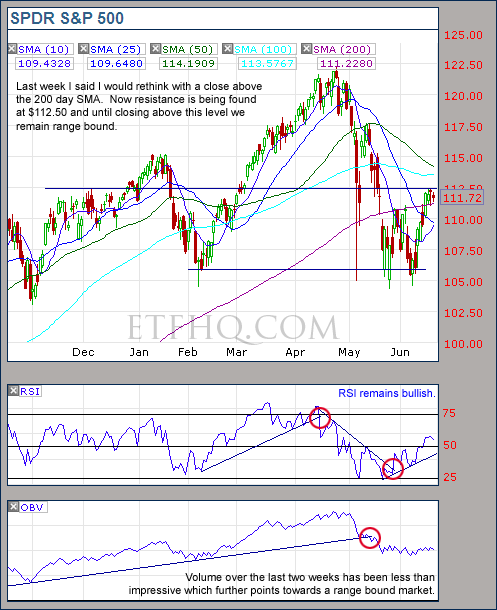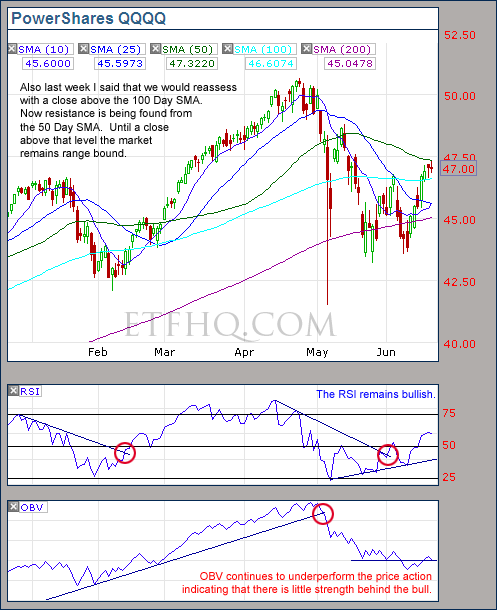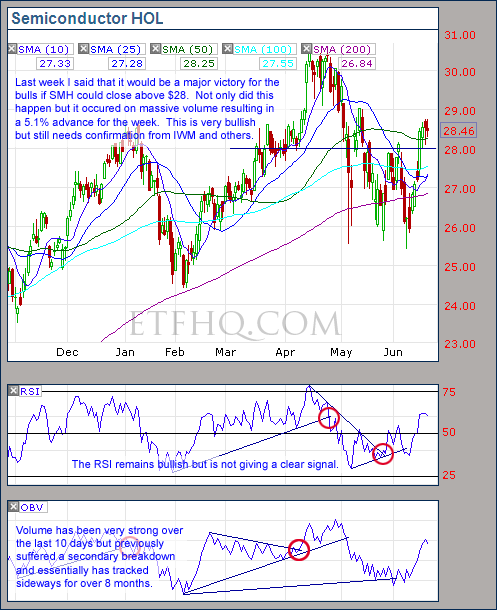June 21, 2010 – 12:35 am ET
A warm welcome to our 70+ new subscribers over the last week :). We don’t have any marketing running so a MASSIVE thanks to YOU for spreading the word!!
Now from on behalf of New Zealand I would like to congratulate Di Rossi for the outstanding acting that earned Italy that penalty (without which NZ would have had a historic victory). They had to do something I guess? The defending champs can’t go down to the All Whites… some of our players needed to get time off work to go to the world cup while Italy’s team’s combined net worth is greater than NZ’s GDP (note – may not be factual). GO KIWI!!
BTW – We have updated the Moving Average – Simple vs Exponential research to include short trades, enjoy.
.
To The Markets – I was very surprised by the strength of the market over the last week as multiple resistance levels were broken, but some important levels remain.
.
ETF % Change Comparison
.
Over the last week it was SMH and QQQQ that lead the market higher which is very bullish to see. Despite this, most of the influential ETFs are a similar distance from their recent peaks so little of value can currently be taken from these numbers.
.
What the % Comparison Table Tells Us:
By comparing the performance of the economically sensitive (SMH, QQQQ, IWM, IYT) and the comparatively stable ETFs (SPY and DIA) we can get an indication of the true market direction. The more sensitive areas of the market tend to be the first to initiate a trend change. For example if DIA and SPY sell off heavily while SMH and IWM (Russell 2000 small cap ETF) sell of mildly or continue moving to new highs then this would be very positive and vice versa.
The ‘Average Rank %’ is calculated by subtracting the % change for each ETF from the maximum % change and dividing it by the range for each period. 1-((MAX(% change all ETFs)-ETFs % Change)/(MAX(% change all ETFs)-MIN(% change all ETFs))) The readings for each period are then averaged. This reading is provided because if one ETF was significantly under/out performing the others then a plain high or low rank would not accurately reflect this.
.
![]()
.
A Look at the Charts
.

SPY advanced on light volume and has now encountered resistance at $112.50. If the market is to continue moving higher then SMH and IWM will need to lead the way.
.

QQQQ had a great week but also on light volume. To break through the 50 Day SMA will require encouragement from the Small Caps and the Semiconductors.
.
 .
.
SMH won a major victory by smashing through $28 resistance on solid volume. Semiconductors lead the business cycle so it is very positive when they are receiving buying interest. This move has not yet been confirmed by IWM however and until it has been, the market remains range bound.
.

IWM was the only ETF not to confirm the latest advanced by breaking through resistance. With a close above $67.50 it will be time to take the bulls very seriously.
.
IYT continues to display very healthy volume flows and broke through resistance at $80. It would be very difficult for the Transports to behave like this if the market was about to suffer a major fall.
.
![]()
.
OM3 Weekly Indicator
.

The OM3 Indicator has issued ‘Bull Alerts’ across the board which is good but otherwise signals are mixed which is typical in a trendless market.
.
How to read the OM3 indicator
The OM3 indicator as with most of our models primarily reads price action and volume. The strong/weak buy/sell signals are self-explanatory. ‘No Signal’ means that the component readings are in conflict and cancel each other out.
The alerts let you know if the cycle is speeding up or slowing down, so when you get at ‘Strong Buy, Bear Alert’ for instance it simply means that the criteria for a strong buy is in place but this weeks cycle reading is weaker (or more bearish) than last weeks reading (the same is true in reverse).
The number of weeks that a signal has been repeated is displayed. Historically a ‘Strong Buy’ signal has lasted for an average of 6 weeks and a maximum of 42 weeks, while a ‘Strong Sell’ has lasted for an average of 4 weeks and a maximum of 16.
This is an indicator not a mechanical trading model. It is useful to assist in analyzing the market but for the best results should be combined with commonsense and support/resistance levels etc.
.
![]()
.
TransDow & NasDow
.
The Transports remain dominant over the Dow after 112 days. During that time they have advanced 7.23% compared to just 1.21% for the Dow.
The NasDow still has No Signal as there is no clearly dominant index between the NASDAQ and the Dow.
.
What the TransDow Readings tell us:
The TransDow measures dominance between the DJ Transportation Index (DJTI) and the Dow Jones Industrial Average (DJIA). In a strong market the more economically sensitive Transportation Index should be dominant over the DJIA.
Historically the DJTI has been dominant over the Dow 45% of the time. The annualized rate of return from the DJTI during this period was 18.47% with the biggest loss for one trade sitting at -13.27%. The annualized return from the DJIA during the periods it was dominant over the DJTI was just 4.06% and the biggest loss for one trade was -16.13%. A 4% stop-loss is applied to all trades adjusting positions only at the end of the week.
What the NasDow Readings tell us:
The NasDow measures dominance between the NASDAQ and the DJIA. Using the same theory behind the Trans Dow; in a strong market the more economically sensitive NASDAQ should be dominant over the DJIA.
Historically the NASDAQ has been dominant over the DJIA 44% of the time. Taking only the trades when the NASDAQ is above its 40 week moving average the annualized rate of return was 25.47% with the biggest loss for one trade sitting at –8.59%. The annualized rate on the DJIA during the periods it was dominant over the NASDAQ is just 8.88% and the biggest loss for one trade was –12.28%. A 8% stop-loss is applied to all trades adjusting positions only at the end of the week.
.
![]()
.
LTMF 80 & Liquid Q
.

LTMF 80 opened a fresh position in QQQQ on Friday while Liquid Q remains in cash.
.
Historical Stats:
.

.
How The LTMF 80 Works
LTMF stands for Long Term Market Forecaster. It reads volume flows relative to price action and looks for out performance of volume measured on a percentage basis over the prior 12 months. During a sustained rally the readings will reach high levels (near 100%) making it imposable for the volume reading to always outperform price so any reading above 80% will maintain the buy signal. This system has outperformed the market over the last 10 years but performance has been damaged by some nasty losses. It only produces buy signals and only for QQQQ.
How Liquid Q Works
Liquid Q completely ignores price action and instead measures the relative flow of money between a selection of economically sensitive and comparatively stable ares of the market. It looks for times when the smart money is confident and and can be seen by through volume investing heavily is more risky areas due to an expectation of expansion. This system has outperformed the market over the last 10 years and remained in cash through most of the major declines. It only produces buy signals and only for QQQQ. We will provide more performance details on the web site for these systems soon.
.
![]()
.
Summary
.
There has been a battle between support and resistance raging for a while now along with several conflicting factors. Over the last week we saw IWM stall at resistance, SPY and QQQQ break through on weak volume while SMH and IYT break through on strong volume.
Last week I was looking for SMH above $28, IWM above $67.50 and IYT above $80. IWM was the only one to fail at resistance and as a result we remain range bound. Now I am looking for the following to indicate a return to the bull market:
- SPY close above $112.50
- QQQQ close above its 50 Day SMA
- SMH remain above $80
- IWM close above $67.50
- IYT close above its 50 Day SMA
.
Any disputes, questions, queries, comments or theories are most welcome in the comments section below.
.
Derry
And the Team @ ETF HQ
“Equipping you to win on Wall St so that you can reach your financial goals.”
.
P.S Like ETFHQ on Facebook – HERE
.
![]()
.
The Devils Dictionary – V
V-Shaped Recovery – An opportunity for economists to incorrectly predict the timing and nature of the recession’s end just as successfully as they incorrectly predicted its inception, depth and duration. Variants include the U-shaped recovery, L-shaped recovery and :- ( shaped recovery.
Value Investing – The art of buying low and selling lower.
Volatile – The temperament of your average trader on a bad day; the likely future state of financial markets after long periods of low interest rates.
W
Warren Buffett – Ebenezer Scrooge with better PR.
You said: “QQQQ. To break through the 50 Day SMA will require encouragement from the Small Caps and the Semiconductors.”
As you know, I am sure that QQQQ has broken through 50 EMA, which now act as support. In your opinion, which one is more important; 50 SMA or EMA? In other words, which one traders follow more often? Of course the one that most traders follow would be more important to watch.
Hi Tim,
Great question. For use in a mechanical trading model (without any human interpretation) the 50 Day EMA will produce better returns. However the 50 SMA is more widely followed and you are right in saying that it is more important to watch for discretionary trading. You will find in-depth statistics on how each different average behaves here – http://etfhq.com/blog/2010/06/03/moving-average…
I hope that the market is treating you well, let me know if you have any other questions.
Cheers
Derry